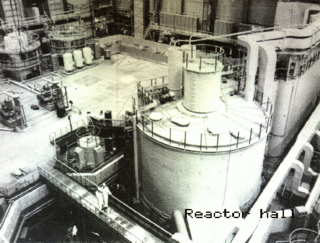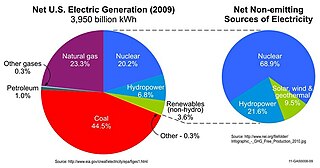
The United States Nuclear Regulatory Commission (NRC) is an independent agency of the United States government tasked with protecting public health and safety related to nuclear energy. Established by the Energy Reorganization Act of 1974, the NRC began operations on January 19, 1975, as one of two successor agencies to the United States Atomic Energy Commission. Its functions include overseeing reactor safety and security, administering reactor licensing and renewal, licensing radioactive materials, radionuclide safety, and managing the storage, security, recycling, and disposal of spent fuel.

Idaho National Laboratory (INL) is one of the national laboratories of the United States Department of Energy and is managed by the Battelle Energy Alliance. Historically, the lab has been involved with nuclear research, although the laboratory does other research as well. Much of current knowledge about how nuclear reactors behave and misbehave was discovered at what is now Idaho National Laboratory. John Grossenbacher, former INL director, said, "The history of nuclear energy for peaceful application has principally been written in Idaho".

Columbia Generating Station is a nuclear commercial energy facility located on the Hanford Site, 10 miles (16 km) north of Richland, Washington. It is owned and operated by Energy Northwest, a Washington state, not-for-profit joint operating agency. Licensed by the Nuclear Regulatory Commission in 1983, Columbia first produced electricity in May 1984, and entered commercial operation in December 1984.

The Energy Policy Act of 2005 is a federal law signed by President George W. Bush on August 8, 2005, at Sandia National Laboratories in Albuquerque, New Mexico. The act, described by proponents as an attempt to combat growing energy problems, changed US energy policy by providing tax incentives and loan guarantees for energy production of various types. The most consequential aspect of the law was to greatly increase ethanol production to be blended with gasoline. The law also repealed the Public Utility Holding Company Act of 1935, effective February 2006.

In the United States, nuclear power is provided by 94 commercial reactors with a net capacity of 97 gigawatts (GW), with 63 pressurized water reactors and 31 boiling water reactors. In 2019, they produced a total of 809.41 terawatt-hours of electricity, which accounted for 20% of the nation's total electric energy generation. In 2018, nuclear comprised nearly 50 percent of US emission-free energy generation.

The BN-350 was a sodium-cooled, fast reactor located at the Mangyshlak Nuclear Power Plant, located in Aktau, Kazakhstan, on the shore of the Caspian Sea.

World Nuclear Association is the international organization that promotes nuclear power and supports the companies that comprise the global nuclear industry. Its members come from all parts of the nuclear fuel cycle, including uranium mining, uranium conversion, uranium enrichment, nuclear fuel fabrication, plant manufacture, transport, and the disposal of used nuclear fuel, as well as electricity generation itself.
In Pakistan, nuclear power is provided by six commercial nuclear power plants with a net capacity of 3,262 megawatts (3.262 GW) from pressurized water reactors. In 2020, Pakistan's nuclear power plants produced a total of 133 terawatt-hours of electricity, which accounted for roughly 10% of the nation's total electric energy generation.

The Edison Electric Institute (EEI) is an association that represents all U.S. investor-owned electric companies.
The Atomic Industrial Forum (AIF) was an industrial policy organization for the commercial development of nuclear power and energy.

Nuclear power construction costs have varied significantly across the world and over time. Large and rapid increases in costs occurred during the 1970s, especially in the United States. Recent cost trends in countries such as Japan and Korea have been very different, including periods of stability and decline in construction costs.

The Atomic Energy Regulatory Board (AERB) was constituted on 15 November 1983 by the President of India by exercising the powers conferred by Section 27 of the Atomic Energy Act, 1962 to carry out certain regulatory and safety functions under the Act. The regulatory authority of AERB is derived from the rules and notifications promulgated under the Atomic Energy Act, 1962 and the Environmental (Protection) Act, 1986. The headquarters is in Mumbai.

Energy laws govern the use and taxation of energy, both renewable and non-renewable. These laws are the primary authorities related to energy. In contrast, energy policy refers to the policy and politics of energy.

Between 2007 and 2009, 13 companies applied to the Nuclear Regulatory Commission (NRC) for construction and operating licenses to build 31 new nuclear power reactors in the United States. However, the case for widespread nuclear plant construction has been hampered due to inexpensive natural gas, slow electricity demand growth in a weak US economy, lack of financing, and safety concerns following the Fukushima nuclear accident at a plant built in the early 1970s which occurred in 2011.

The Light Water Reactor Sustainability Program is a U.S. government research and development program. It is directed by the United States Department of Energy and is aimed at performing research and compiling data necessary to qualify for licenses to extend the life of America's current 104 electricity generating nuclear power plants beyond 60 years of life. Practically all of the commercial electric-generating nuclear power plants currently in the United States are light water reactor (LWR) plants, meaning they use ordinary (light) water as a moderator and coolant simultaneously.

Energy in Uruguay describes energy and electricity production, consumption and import in Uruguay. As part of climate mitigation measures and an energy transformation, Uruguay has converted over 98% of its electrical grid to sustainable energy sources. Fossil fuels are primarily imported into Uruguay for transportation, industrial uses and applications like domestic cooking. Four hydroelectric dams provide much of the country's energy supply.

The nuclear energy policy of the United States began in 1954 and continued with the ongoing building of nuclear power plants, the enactment of numerous pieces of legislation such as the Energy Reorganization Act of 1974, and the implementation of countless policies which have guided the Nuclear Regulatory Commission and the Department of Energy in the regulation and growth of nuclear energy companies. This includes, but is not limited to, regulations of nuclear facilities, waste storage, decommissioning of weapons-grade materials, uranium mining, and funding for nuclear companies, along with an increase in power plant building. Both legislation and bureaucratic regulations of nuclear energy in the United States have been shaped by scientific research, private industries' wishes, and public opinion, which has shifted over time and as a result of different nuclear disasters.
The Office of Nuclear Energy (NE) is an agency of the United States Department of Energy which promotes nuclear power as a resource capable of meeting the energy, environmental, and national security needs of the United States by resolving technical and regulatory barriers through research, development, and demonstration.
This is a history of nuclear power as realized through the first artificial fission of atoms that would lead to the Manhattan Project and, eventually, to using nuclear fission to generate electricity.
















